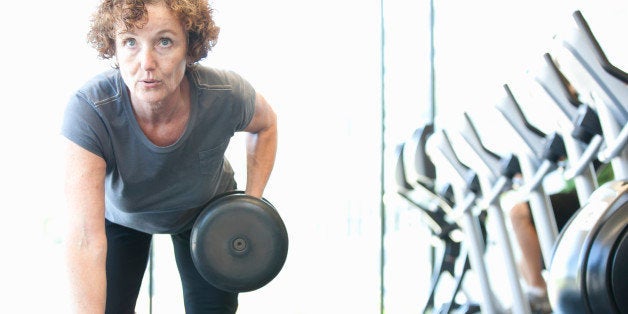
Pull up your leg warmers and tie a sweatband around your forehead. Let's get physical. Having talked about the things that motivate us to be fit in our later years, I'd like to connect specific exercises that build muscle strength and stamina to the things they support in everyday life, from shoulders to "abs" and ankles.
Taking it from the top... you use your upper body to move, haul, create and orchestrate. The major muscle groups to develop include your chest and back, shoulders and arms. Given the increasing importance of the hands in this modern rra, let's throw in wrists and hands.
Strong chest and back muscleshelp you lift, carry and push. They aid your posture, which gives your lungs and other organs room to breathe, helps your spine stay long and strong and lets clothes hang well. Muscle endurance in this group will help you do things like carry your own suitcase, pack up your house to downsize, spring clean and hold your grandkids for a nice, long time. It's easier to lift moving boxes, carry casseroles, pursue favorite sports, handle the steering wheel, walk a lively dog and load and close the trunk of the car.
The shoulders are the most flexible joint in the body, allowing you to move your arms and hands freely, productively and expressively. Unfortunately, their very looseness makes them more vulnerable to injury. Working the front, top and back muscles in the shoulder girdle, as well as the small muscles that allow for rotation, will help you to prevent injury and enjoy carrying shopping bags, putting away the dishes and hanging up your clothes, writing on a blackboard/whiteboard, and conducting music.
Almost forgot -- keeping your neck strong and loose sure makes it easy to check that blind spot while driving.
Although the wrist, hand and finger muscles are small and often neglected in typical weight-lifting routines, these essential muscles help you to tie your shoes, button your clothes, cook, write, paint, do crafts, drive, play instruments, work on a keyboard, handle a camera, brush your teeth, tickle your grandkids and more. They're increasingly important in this button-laden touch-screen world. Give them some love. Even squeezing a rubber ball while you watch TV can help strengthen your hands. Wrist rotations can help maintain flexibility.
Moving on to the core muscles, a whole host of deep and superficial abdominal and back muscles work in concert to provide stability, balance and overall oomph. The hip muscles and the "glutes" (maximus, minimus and more) enable mobility -- walking, running, dancing, the transitions from sitting to standing (and reverse), lunging, using the stairs. These additional trunk muscles work with the abdomen and back to stabilize your stance. You want that. Given the fears about falls, you really want that.
Strong leg muscles -- the fronts and backs of your upper legs (your quadriceps and hamstrings), your calves (well hello there, gastrocnemius), and even the fronts of your shins and your ankles -- propel you in space, allowing for a freedom and mobility that you are likely loathe to lose. Strong lower bodies help you tackle stairs, move in and out of a seated position, cross streets to beat the light, control the gas and brake pedals, plow through snowbanks, peddle a bike and dance the night away. (Check that link; I defy you to stay still.) Strong lower-leg muscles not only boost circulation of fluid back up from the lower body, but also keep you springy and quick.
As with the wrists and hands, make some time to work your ankles and feet. Strong and flexible ankles keep the gait more agile, allowing you to handle changes in surface and maneuver around obstacles without falling. Even moving a towel around on the floor (another TV-friendly exercise), and writing the alphabet with your toes, will bring real benefits.
Geeks like me like knowing the physiological changes that come with lifting weights - how muscles grow, lungs expand, circulation improves, joints get supported and bones stay strong. (And sleep improves and so does mood... gosh, do you think they're related?)
But most people are not geeks like me. And most of them didn't certify to teach group fitness to older adults, the way I did in midlife -- for kicks and to break up with my physical therapist.
For most of us, maybe it's enough to know that working our muscles against resistance (see a discussion of free weights vs. machines here), following a balanced program modified to respect our individual "issues," can significantly increase our ability to stay strong, endure life's physical and mental challenges, and be more free of pain and accidental injury.
A series of simple, easy-to-learn exercises using free weights (or dumbbells) on a mat, chair or weight bench can help most people develop their marvelous life-enhancing muscles and live a stronger, even longer life.
If you'd like to learn more about your amazing muscle anatomy, check out a muscle chart or one of the many beautifully illustrated books on how your muscles work in strength training, stretching, yoga, etc. (Great gifts for yourself or for the fitness rookie in your life.) Online resources also show you how everything works. My book devotes a chapter to home-based fitness and lists helpful resources in its appendix.